Revisiting Understanding Entrepreneurs Using the Myers-Briggs Type Indicator
VerifiedAdded on 2022/12/30
|7
|3253
|1
AI Summary
This paper discusses the use of the Myers-Briggs Type Indicator (MBTI) in understanding and developing entrepreneurship. It explores the role of intuition in entrepreneurial personality and behavior, and suggests that the MBTI can be a useful tool in evaluating and researching this.
Contribute Materials
Your contribution can guide someone’s learning journey. Share your
documents today.
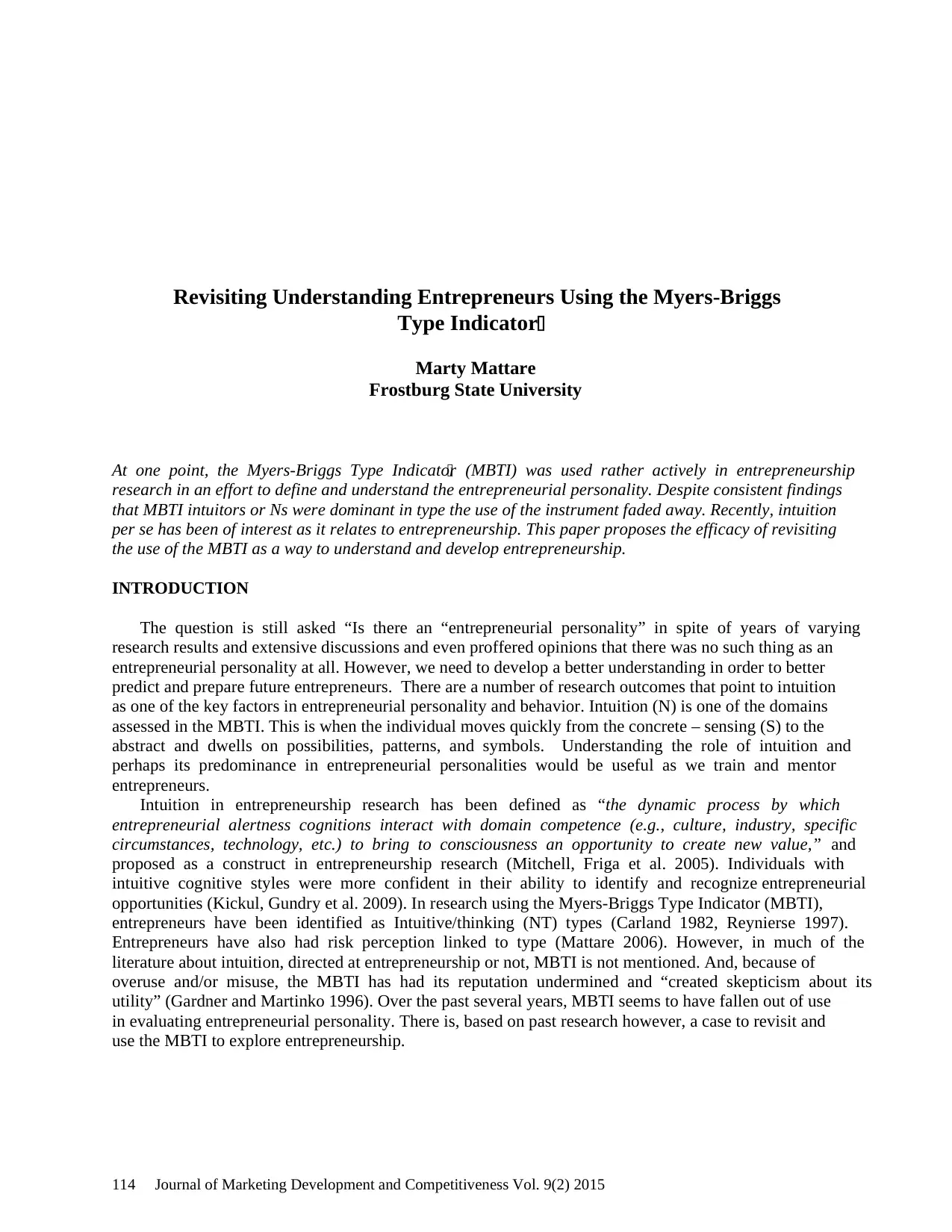
Revisiting Understanding Entrepreneurs Using the Myers-Briggs
Type Indicator
Marty Mattare
Frostburg State University
At one point, the Myers-Briggs Type Indicator (MBTI) was used rather actively in entrepreneurship
research in an effort to define and understand the entrepreneurial personality. Despite consistent findings
that MBTI intuitors or Ns were dominant in type the use of the instrument faded away. Recently, intuition
per se has been of interest as it relates to entrepreneurship. This paper proposes the efficacy of revisiting
the use of the MBTI as a way to understand and develop entrepreneurship.
INTRODUCTION
The question is still asked “Is there an “entrepreneurial personality” in spite of years of varying
research results and extensive discussions and even proffered opinions that there was no such thing as an
entrepreneurial personality at all. However, we need to develop a better understanding in order to better
predict and prepare future entrepreneurs. There are a number of research outcomes that point to intuition
as one of the key factors in entrepreneurial personality and behavior. Intuition (N) is one of the domains
assessed in the MBTI. This is when the individual moves quickly from the concrete – sensing (S) to the
abstract and dwells on possibilities, patterns, and symbols. Understanding the role of intuition and
perhaps its predominance in entrepreneurial personalities would be useful as we train and mentor
entrepreneurs.
Intuition in entrepreneurship research has been defined as “the dynamic process by which
entrepreneurial alertness cognitions interact with domain competence (e.g., culture, industry, specific
circumstances, technology, etc.) to bring to consciousness an opportunity to create new value,” and
proposed as a construct in entrepreneurship research (Mitchell, Friga et al. 2005). Individuals with
intuitive cognitive styles were more confident in their ability to identify and recognize entrepreneurial
opportunities (Kickul, Gundry et al. 2009). In research using the Myers-Briggs Type Indicator (MBTI),
entrepreneurs have been identified as Intuitive/thinking (NT) types (Carland 1982, Reynierse 1997).
Entrepreneurs have also had risk perception linked to type (Mattare 2006). However, in much of the
literature about intuition, directed at entrepreneurship or not, MBTI is not mentioned. And, because of
overuse and/or misuse, the MBTI has had its reputation undermined and “created skepticism about its
utility” (Gardner and Martinko 1996). Over the past several years, MBTI seems to have fallen out of use
in evaluating entrepreneurial personality. There is, based on past research however, a case to revisit and
use the MBTI to explore entrepreneurship.
114 Journal of Marketing Development and Competitiveness Vol. 9(2) 2015
Type Indicator
Marty Mattare
Frostburg State University
At one point, the Myers-Briggs Type Indicator (MBTI) was used rather actively in entrepreneurship
research in an effort to define and understand the entrepreneurial personality. Despite consistent findings
that MBTI intuitors or Ns were dominant in type the use of the instrument faded away. Recently, intuition
per se has been of interest as it relates to entrepreneurship. This paper proposes the efficacy of revisiting
the use of the MBTI as a way to understand and develop entrepreneurship.
INTRODUCTION
The question is still asked “Is there an “entrepreneurial personality” in spite of years of varying
research results and extensive discussions and even proffered opinions that there was no such thing as an
entrepreneurial personality at all. However, we need to develop a better understanding in order to better
predict and prepare future entrepreneurs. There are a number of research outcomes that point to intuition
as one of the key factors in entrepreneurial personality and behavior. Intuition (N) is one of the domains
assessed in the MBTI. This is when the individual moves quickly from the concrete – sensing (S) to the
abstract and dwells on possibilities, patterns, and symbols. Understanding the role of intuition and
perhaps its predominance in entrepreneurial personalities would be useful as we train and mentor
entrepreneurs.
Intuition in entrepreneurship research has been defined as “the dynamic process by which
entrepreneurial alertness cognitions interact with domain competence (e.g., culture, industry, specific
circumstances, technology, etc.) to bring to consciousness an opportunity to create new value,” and
proposed as a construct in entrepreneurship research (Mitchell, Friga et al. 2005). Individuals with
intuitive cognitive styles were more confident in their ability to identify and recognize entrepreneurial
opportunities (Kickul, Gundry et al. 2009). In research using the Myers-Briggs Type Indicator (MBTI),
entrepreneurs have been identified as Intuitive/thinking (NT) types (Carland 1982, Reynierse 1997).
Entrepreneurs have also had risk perception linked to type (Mattare 2006). However, in much of the
literature about intuition, directed at entrepreneurship or not, MBTI is not mentioned. And, because of
overuse and/or misuse, the MBTI has had its reputation undermined and “created skepticism about its
utility” (Gardner and Martinko 1996). Over the past several years, MBTI seems to have fallen out of use
in evaluating entrepreneurial personality. There is, based on past research however, a case to revisit and
use the MBTI to explore entrepreneurship.
114 Journal of Marketing Development and Competitiveness Vol. 9(2) 2015
Secure Best Marks with AI Grader
Need help grading? Try our AI Grader for instant feedback on your assignments.
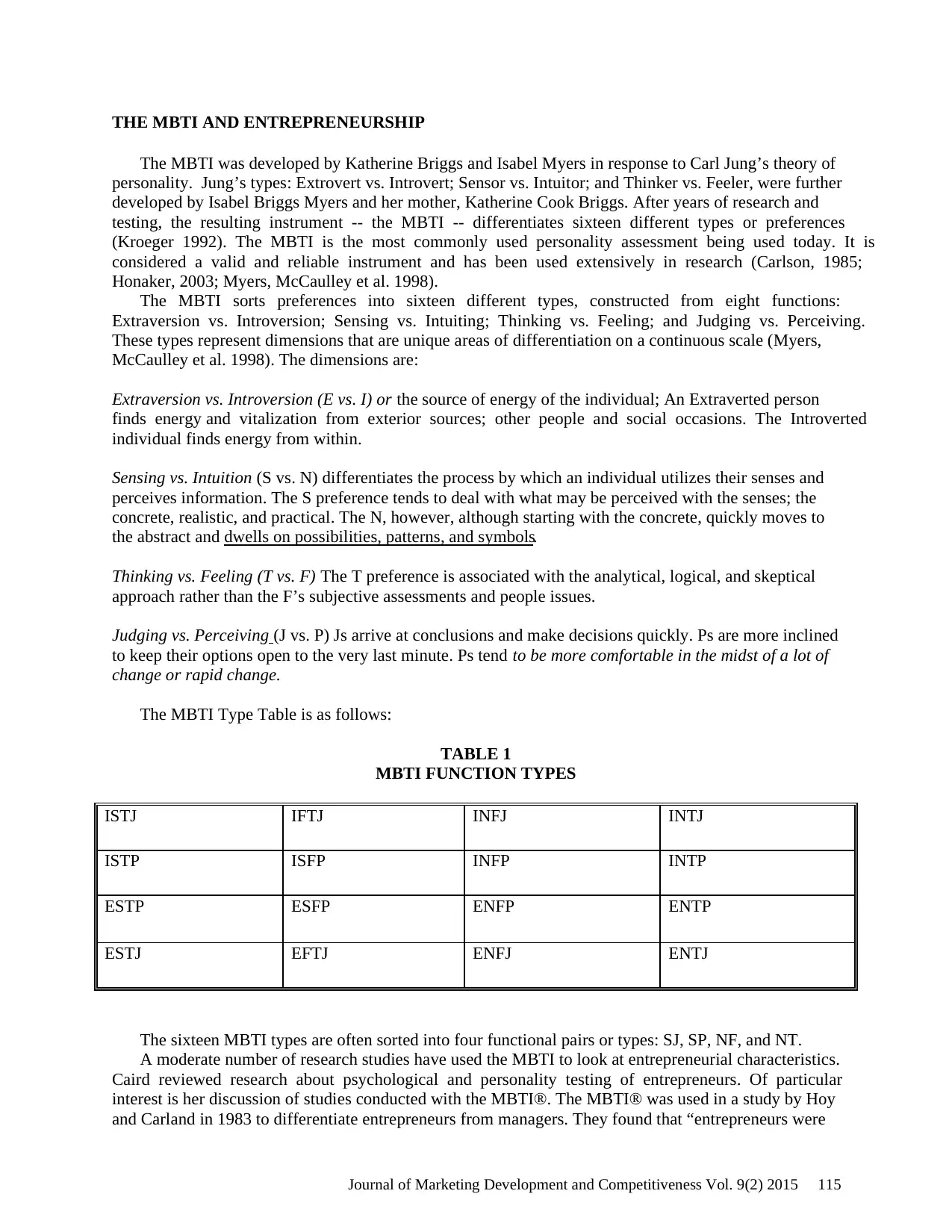
THE MBTI AND ENTREPRENEURSHIP
The MBTI was developed by Katherine Briggs and Isabel Myers in response to Carl Jung’s theory of
personality. Jung’s types: Extrovert vs. Introvert; Sensor vs. Intuitor; and Thinker vs. Feeler, were further
developed by Isabel Briggs Myers and her mother, Katherine Cook Briggs. After years of research and
testing, the resulting instrument -- the MBTI -- differentiates sixteen different types or preferences
(Kroeger 1992). The MBTI is the most commonly used personality assessment being used today. It is
considered a valid and reliable instrument and has been used extensively in research (Carlson, 1985;
Honaker, 2003; Myers, McCaulley et al. 1998).
The MBTI sorts preferences into sixteen different types, constructed from eight functions:
Extraversion vs. Introversion; Sensing vs. Intuiting; Thinking vs. Feeling; and Judging vs. Perceiving.
These types represent dimensions that are unique areas of differentiation on a continuous scale (Myers,
McCaulley et al. 1998). The dimensions are:
Extraversion vs. Introversion (E vs. I) or the source of energy of the individual; An Extraverted person
finds energy and vitalization from exterior sources; other people and social occasions. The Introverted
individual finds energy from within.
Sensing vs. Intuition (S vs. N) differentiates the process by which an individual utilizes their senses and
perceives information. The S preference tends to deal with what may be perceived with the senses; the
concrete, realistic, and practical. The N, however, although starting with the concrete, quickly moves to
the abstract and dwells on possibilities, patterns, and symbols.
Thinking vs. Feeling (T vs. F) The T preference is associated with the analytical, logical, and skeptical
approach rather than the F’s subjective assessments and people issues.
Judging vs. Perceiving (J vs. P) Js arrive at conclusions and make decisions quickly. Ps are more inclined
to keep their options open to the very last minute. Ps tend to be more comfortable in the midst of a lot of
change or rapid change.
The MBTI Type Table is as follows:
TABLE 1
MBTI FUNCTION TYPES
ISTJ IFTJ INFJ INTJ
ISTP ISFP INFP INTP
ESTP ESFP ENFP ENTP
ESTJ EFTJ ENFJ ENTJ
The sixteen MBTI types are often sorted into four functional pairs or types: SJ, SP, NF, and NT.
A moderate number of research studies have used the MBTI to look at entrepreneurial characteristics.
Caird reviewed research about psychological and personality testing of entrepreneurs. Of particular
interest is her discussion of studies conducted with the MBTI®. The MBTI® was used in a study by Hoy
and Carland in 1983 to differentiate entrepreneurs from managers. They found that “entrepreneurs were
Journal of Marketing Development and Competitiveness Vol. 9(2) 2015 115
The MBTI was developed by Katherine Briggs and Isabel Myers in response to Carl Jung’s theory of
personality. Jung’s types: Extrovert vs. Introvert; Sensor vs. Intuitor; and Thinker vs. Feeler, were further
developed by Isabel Briggs Myers and her mother, Katherine Cook Briggs. After years of research and
testing, the resulting instrument -- the MBTI -- differentiates sixteen different types or preferences
(Kroeger 1992). The MBTI is the most commonly used personality assessment being used today. It is
considered a valid and reliable instrument and has been used extensively in research (Carlson, 1985;
Honaker, 2003; Myers, McCaulley et al. 1998).
The MBTI sorts preferences into sixteen different types, constructed from eight functions:
Extraversion vs. Introversion; Sensing vs. Intuiting; Thinking vs. Feeling; and Judging vs. Perceiving.
These types represent dimensions that are unique areas of differentiation on a continuous scale (Myers,
McCaulley et al. 1998). The dimensions are:
Extraversion vs. Introversion (E vs. I) or the source of energy of the individual; An Extraverted person
finds energy and vitalization from exterior sources; other people and social occasions. The Introverted
individual finds energy from within.
Sensing vs. Intuition (S vs. N) differentiates the process by which an individual utilizes their senses and
perceives information. The S preference tends to deal with what may be perceived with the senses; the
concrete, realistic, and practical. The N, however, although starting with the concrete, quickly moves to
the abstract and dwells on possibilities, patterns, and symbols.
Thinking vs. Feeling (T vs. F) The T preference is associated with the analytical, logical, and skeptical
approach rather than the F’s subjective assessments and people issues.
Judging vs. Perceiving (J vs. P) Js arrive at conclusions and make decisions quickly. Ps are more inclined
to keep their options open to the very last minute. Ps tend to be more comfortable in the midst of a lot of
change or rapid change.
The MBTI Type Table is as follows:
TABLE 1
MBTI FUNCTION TYPES
ISTJ IFTJ INFJ INTJ
ISTP ISFP INFP INTP
ESTP ESFP ENFP ENTP
ESTJ EFTJ ENFJ ENTJ
The sixteen MBTI types are often sorted into four functional pairs or types: SJ, SP, NF, and NT.
A moderate number of research studies have used the MBTI to look at entrepreneurial characteristics.
Caird reviewed research about psychological and personality testing of entrepreneurs. Of particular
interest is her discussion of studies conducted with the MBTI®. The MBTI® was used in a study by Hoy
and Carland in 1983 to differentiate entrepreneurs from managers. They found that “entrepreneurs were
Journal of Marketing Development and Competitiveness Vol. 9(2) 2015 115
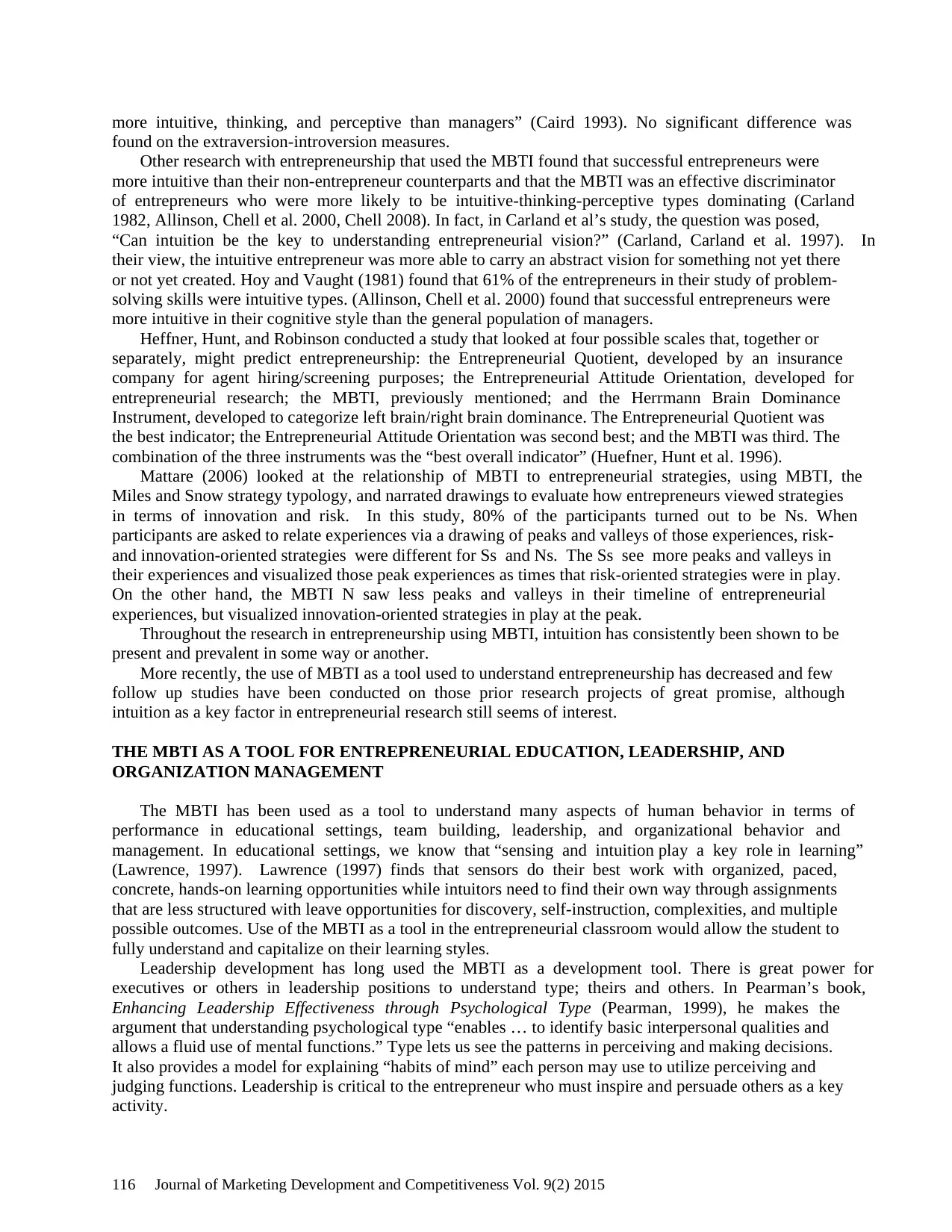
more intuitive, thinking, and perceptive than managers” (Caird 1993). No significant difference was
found on the extraversion-introversion measures.
Other research with entrepreneurship that used the MBTI found that successful entrepreneurs were
more intuitive than their non-entrepreneur counterparts and that the MBTI was an effective discriminator
of entrepreneurs who were more likely to be intuitive-thinking-perceptive types dominating (Carland
1982, Allinson, Chell et al. 2000, Chell 2008). In fact, in Carland et al’s study, the question was posed,
“Can intuition be the key to understanding entrepreneurial vision?” (Carland, Carland et al. 1997). In
their view, the intuitive entrepreneur was more able to carry an abstract vision for something not yet there
or not yet created. Hoy and Vaught (1981) found that 61% of the entrepreneurs in their study of problem-
solving skills were intuitive types. (Allinson, Chell et al. 2000) found that successful entrepreneurs were
more intuitive in their cognitive style than the general population of managers.
Heffner, Hunt, and Robinson conducted a study that looked at four possible scales that, together or
separately, might predict entrepreneurship: the Entrepreneurial Quotient, developed by an insurance
company for agent hiring/screening purposes; the Entrepreneurial Attitude Orientation, developed for
entrepreneurial research; the MBTI, previously mentioned; and the Herrmann Brain Dominance
Instrument, developed to categorize left brain/right brain dominance. The Entrepreneurial Quotient was
the best indicator; the Entrepreneurial Attitude Orientation was second best; and the MBTI was third. The
combination of the three instruments was the “best overall indicator” (Huefner, Hunt et al. 1996).
Mattare (2006) looked at the relationship of MBTI to entrepreneurial strategies, using MBTI, the
Miles and Snow strategy typology, and narrated drawings to evaluate how entrepreneurs viewed strategies
in terms of innovation and risk. In this study, 80% of the participants turned out to be Ns. When
participants are asked to relate experiences via a drawing of peaks and valleys of those experiences, risk-
and innovation-oriented strategies were different for Ss and Ns. The Ss see more peaks and valleys in
their experiences and visualized those peak experiences as times that risk-oriented strategies were in play.
On the other hand, the MBTI N saw less peaks and valleys in their timeline of entrepreneurial
experiences, but visualized innovation-oriented strategies in play at the peak.
Throughout the research in entrepreneurship using MBTI, intuition has consistently been shown to be
present and prevalent in some way or another.
More recently, the use of MBTI as a tool used to understand entrepreneurship has decreased and few
follow up studies have been conducted on those prior research projects of great promise, although
intuition as a key factor in entrepreneurial research still seems of interest.
THE MBTI AS A TOOL FOR ENTREPRENEURIAL EDUCATION, LEADERSHIP, AND
ORGANIZATION MANAGEMENT
The MBTI has been used as a tool to understand many aspects of human behavior in terms of
performance in educational settings, team building, leadership, and organizational behavior and
management. In educational settings, we know that “sensing and intuition play a key role in learning”
(Lawrence, 1997). Lawrence (1997) finds that sensors do their best work with organized, paced,
concrete, hands-on learning opportunities while intuitors need to find their own way through assignments
that are less structured with leave opportunities for discovery, self-instruction, complexities, and multiple
possible outcomes. Use of the MBTI as a tool in the entrepreneurial classroom would allow the student to
fully understand and capitalize on their learning styles.
Leadership development has long used the MBTI as a development tool. There is great power for
executives or others in leadership positions to understand type; theirs and others. In Pearman’s book,
Enhancing Leadership Effectiveness through Psychological Type (Pearman, 1999), he makes the
argument that understanding psychological type “enables … to identify basic interpersonal qualities and
allows a fluid use of mental functions.” Type lets us see the patterns in perceiving and making decisions.
It also provides a model for explaining “habits of mind” each person may use to utilize perceiving and
judging functions. Leadership is critical to the entrepreneur who must inspire and persuade others as a key
activity.
116 Journal of Marketing Development and Competitiveness Vol. 9(2) 2015
found on the extraversion-introversion measures.
Other research with entrepreneurship that used the MBTI found that successful entrepreneurs were
more intuitive than their non-entrepreneur counterparts and that the MBTI was an effective discriminator
of entrepreneurs who were more likely to be intuitive-thinking-perceptive types dominating (Carland
1982, Allinson, Chell et al. 2000, Chell 2008). In fact, in Carland et al’s study, the question was posed,
“Can intuition be the key to understanding entrepreneurial vision?” (Carland, Carland et al. 1997). In
their view, the intuitive entrepreneur was more able to carry an abstract vision for something not yet there
or not yet created. Hoy and Vaught (1981) found that 61% of the entrepreneurs in their study of problem-
solving skills were intuitive types. (Allinson, Chell et al. 2000) found that successful entrepreneurs were
more intuitive in their cognitive style than the general population of managers.
Heffner, Hunt, and Robinson conducted a study that looked at four possible scales that, together or
separately, might predict entrepreneurship: the Entrepreneurial Quotient, developed by an insurance
company for agent hiring/screening purposes; the Entrepreneurial Attitude Orientation, developed for
entrepreneurial research; the MBTI, previously mentioned; and the Herrmann Brain Dominance
Instrument, developed to categorize left brain/right brain dominance. The Entrepreneurial Quotient was
the best indicator; the Entrepreneurial Attitude Orientation was second best; and the MBTI was third. The
combination of the three instruments was the “best overall indicator” (Huefner, Hunt et al. 1996).
Mattare (2006) looked at the relationship of MBTI to entrepreneurial strategies, using MBTI, the
Miles and Snow strategy typology, and narrated drawings to evaluate how entrepreneurs viewed strategies
in terms of innovation and risk. In this study, 80% of the participants turned out to be Ns. When
participants are asked to relate experiences via a drawing of peaks and valleys of those experiences, risk-
and innovation-oriented strategies were different for Ss and Ns. The Ss see more peaks and valleys in
their experiences and visualized those peak experiences as times that risk-oriented strategies were in play.
On the other hand, the MBTI N saw less peaks and valleys in their timeline of entrepreneurial
experiences, but visualized innovation-oriented strategies in play at the peak.
Throughout the research in entrepreneurship using MBTI, intuition has consistently been shown to be
present and prevalent in some way or another.
More recently, the use of MBTI as a tool used to understand entrepreneurship has decreased and few
follow up studies have been conducted on those prior research projects of great promise, although
intuition as a key factor in entrepreneurial research still seems of interest.
THE MBTI AS A TOOL FOR ENTREPRENEURIAL EDUCATION, LEADERSHIP, AND
ORGANIZATION MANAGEMENT
The MBTI has been used as a tool to understand many aspects of human behavior in terms of
performance in educational settings, team building, leadership, and organizational behavior and
management. In educational settings, we know that “sensing and intuition play a key role in learning”
(Lawrence, 1997). Lawrence (1997) finds that sensors do their best work with organized, paced,
concrete, hands-on learning opportunities while intuitors need to find their own way through assignments
that are less structured with leave opportunities for discovery, self-instruction, complexities, and multiple
possible outcomes. Use of the MBTI as a tool in the entrepreneurial classroom would allow the student to
fully understand and capitalize on their learning styles.
Leadership development has long used the MBTI as a development tool. There is great power for
executives or others in leadership positions to understand type; theirs and others. In Pearman’s book,
Enhancing Leadership Effectiveness through Psychological Type (Pearman, 1999), he makes the
argument that understanding psychological type “enables … to identify basic interpersonal qualities and
allows a fluid use of mental functions.” Type lets us see the patterns in perceiving and making decisions.
It also provides a model for explaining “habits of mind” each person may use to utilize perceiving and
judging functions. Leadership is critical to the entrepreneur who must inspire and persuade others as a key
activity.
116 Journal of Marketing Development and Competitiveness Vol. 9(2) 2015
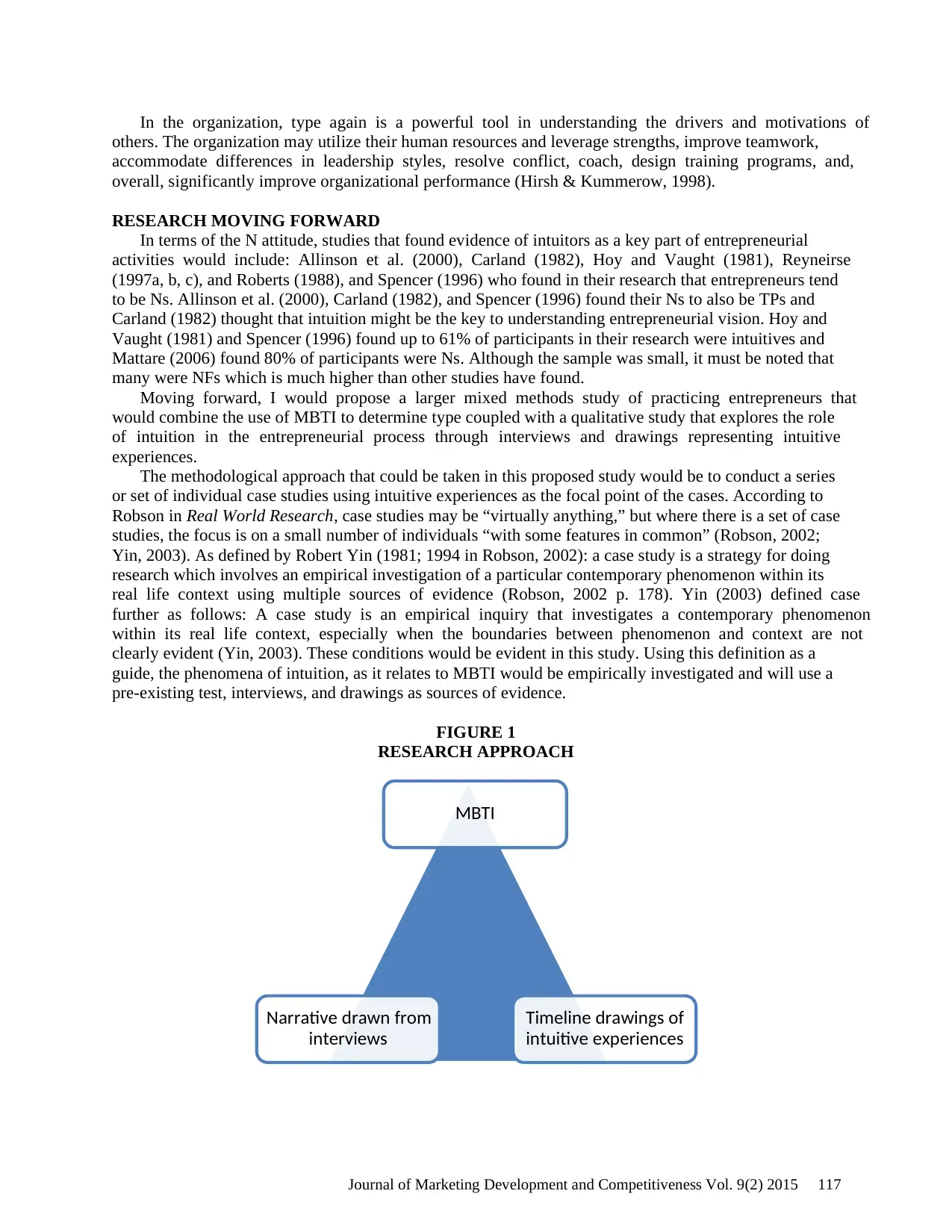
In the organization, type again is a powerful tool in understanding the drivers and motivations of
others. The organization may utilize their human resources and leverage strengths, improve teamwork,
accommodate differences in leadership styles, resolve conflict, coach, design training programs, and,
overall, significantly improve organizational performance (Hirsh & Kummerow, 1998).
RESEARCH MOVING FORWARD
In terms of the N attitude, studies that found evidence of intuitors as a key part of entrepreneurial
activities would include: Allinson et al. (2000), Carland (1982), Hoy and Vaught (1981), Reyneirse
(1997a, b, c), and Roberts (1988), and Spencer (1996) who found in their research that entrepreneurs tend
to be Ns. Allinson et al. (2000), Carland (1982), and Spencer (1996) found their Ns to also be TPs and
Carland (1982) thought that intuition might be the key to understanding entrepreneurial vision. Hoy and
Vaught (1981) and Spencer (1996) found up to 61% of participants in their research were intuitives and
Mattare (2006) found 80% of participants were Ns. Although the sample was small, it must be noted that
many were NFs which is much higher than other studies have found.
Moving forward, I would propose a larger mixed methods study of practicing entrepreneurs that
would combine the use of MBTI to determine type coupled with a qualitative study that explores the role
of intuition in the entrepreneurial process through interviews and drawings representing intuitive
experiences.
The methodological approach that could be taken in this proposed study would be to conduct a series
or set of individual case studies using intuitive experiences as the focal point of the cases. According to
Robson in Real World Research, case studies may be “virtually anything,” but where there is a set of case
studies, the focus is on a small number of individuals “with some features in common” (Robson, 2002;
Yin, 2003). As defined by Robert Yin (1981; 1994 in Robson, 2002): a case study is a strategy for doing
research which involves an empirical investigation of a particular contemporary phenomenon within its
real life context using multiple sources of evidence (Robson, 2002 p. 178). Yin (2003) defined case
further as follows: A case study is an empirical inquiry that investigates a contemporary phenomenon
within its real life context, especially when the boundaries between phenomenon and context are not
clearly evident (Yin, 2003). These conditions would be evident in this study. Using this definition as a
guide, the phenomena of intuition, as it relates to MBTI would be empirically investigated and will use a
pre-existing test, interviews, and drawings as sources of evidence.
FIGURE 1
RESEARCH APPROACH
MBTI
Narrative drawn from
interviews
Timeline drawings of
intuitive experiences
Journal of Marketing Development and Competitiveness Vol. 9(2) 2015 117
others. The organization may utilize their human resources and leverage strengths, improve teamwork,
accommodate differences in leadership styles, resolve conflict, coach, design training programs, and,
overall, significantly improve organizational performance (Hirsh & Kummerow, 1998).
RESEARCH MOVING FORWARD
In terms of the N attitude, studies that found evidence of intuitors as a key part of entrepreneurial
activities would include: Allinson et al. (2000), Carland (1982), Hoy and Vaught (1981), Reyneirse
(1997a, b, c), and Roberts (1988), and Spencer (1996) who found in their research that entrepreneurs tend
to be Ns. Allinson et al. (2000), Carland (1982), and Spencer (1996) found their Ns to also be TPs and
Carland (1982) thought that intuition might be the key to understanding entrepreneurial vision. Hoy and
Vaught (1981) and Spencer (1996) found up to 61% of participants in their research were intuitives and
Mattare (2006) found 80% of participants were Ns. Although the sample was small, it must be noted that
many were NFs which is much higher than other studies have found.
Moving forward, I would propose a larger mixed methods study of practicing entrepreneurs that
would combine the use of MBTI to determine type coupled with a qualitative study that explores the role
of intuition in the entrepreneurial process through interviews and drawings representing intuitive
experiences.
The methodological approach that could be taken in this proposed study would be to conduct a series
or set of individual case studies using intuitive experiences as the focal point of the cases. According to
Robson in Real World Research, case studies may be “virtually anything,” but where there is a set of case
studies, the focus is on a small number of individuals “with some features in common” (Robson, 2002;
Yin, 2003). As defined by Robert Yin (1981; 1994 in Robson, 2002): a case study is a strategy for doing
research which involves an empirical investigation of a particular contemporary phenomenon within its
real life context using multiple sources of evidence (Robson, 2002 p. 178). Yin (2003) defined case
further as follows: A case study is an empirical inquiry that investigates a contemporary phenomenon
within its real life context, especially when the boundaries between phenomenon and context are not
clearly evident (Yin, 2003). These conditions would be evident in this study. Using this definition as a
guide, the phenomena of intuition, as it relates to MBTI would be empirically investigated and will use a
pre-existing test, interviews, and drawings as sources of evidence.
FIGURE 1
RESEARCH APPROACH
MBTI
Narrative drawn from
interviews
Timeline drawings of
intuitive experiences
Journal of Marketing Development and Competitiveness Vol. 9(2) 2015 117
Secure Best Marks with AI Grader
Need help grading? Try our AI Grader for instant feedback on your assignments.
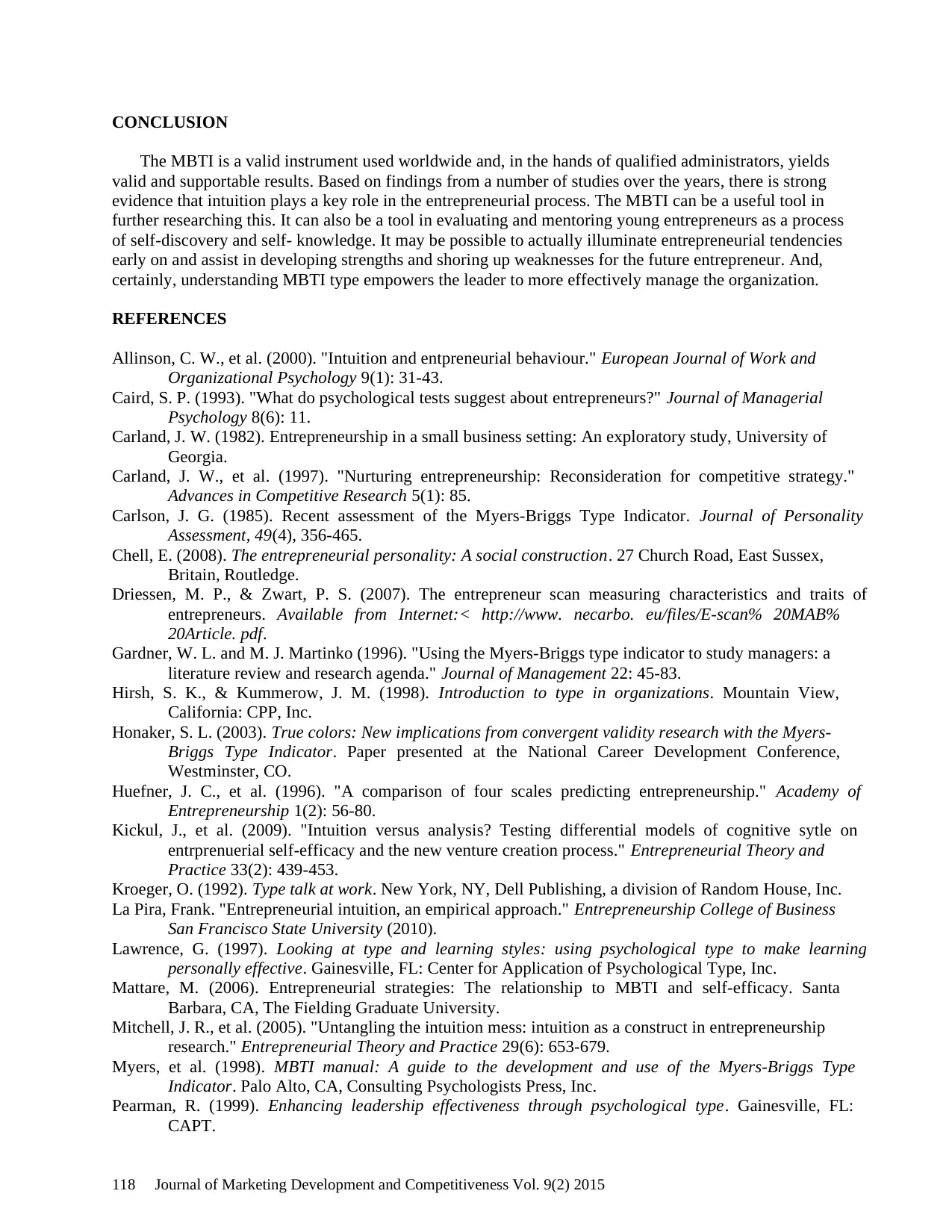
CONCLUSION
The MBTI is a valid instrument used worldwide and, in the hands of qualified administrators, yields
valid and supportable results. Based on findings from a number of studies over the years, there is strong
evidence that intuition plays a key role in the entrepreneurial process. The MBTI can be a useful tool in
further researching this. It can also be a tool in evaluating and mentoring young entrepreneurs as a process
of self-discovery and self- knowledge. It may be possible to actually illuminate entrepreneurial tendencies
early on and assist in developing strengths and shoring up weaknesses for the future entrepreneur. And,
certainly, understanding MBTI type empowers the leader to more effectively manage the organization.
REFERENCES
Allinson, C. W., et al. (2000). "Intuition and entpreneurial behaviour." European Journal of Work and
Organizational Psychology 9(1): 31-43.
Caird, S. P. (1993). "What do psychological tests suggest about entrepreneurs?" Journal of Managerial
Psychology 8(6): 11.
Carland, J. W. (1982). Entrepreneurship in a small business setting: An exploratory study, University of
Georgia.
Carland, J. W., et al. (1997). "Nurturing entrepreneurship: Reconsideration for competitive strategy."
Advances in Competitive Research 5(1): 85.
Carlson, J. G. (1985). Recent assessment of the Myers-Briggs Type Indicator. Journal of Personality
Assessment, 49(4), 356-465.
Chell, E. (2008). The entrepreneurial personality: A social construction. 27 Church Road, East Sussex,
Britain, Routledge.
Driessen, M. P., & Zwart, P. S. (2007). The entrepreneur scan measuring characteristics and traits of
entrepreneurs. Available from Internet:< http://www. necarbo. eu/files/E-scan% 20MAB%
20Article. pdf.
Gardner, W. L. and M. J. Martinko (1996). "Using the Myers-Briggs type indicator to study managers: a
literature review and research agenda." Journal of Management 22: 45-83.
Hirsh, S. K., & Kummerow, J. M. (1998). Introduction to type in organizations. Mountain View,
California: CPP, Inc.
Honaker, S. L. (2003). True colors: New implications from convergent validity research with the Myers-
Briggs Type Indicator. Paper presented at the National Career Development Conference,
Westminster, CO.
Huefner, J. C., et al. (1996). "A comparison of four scales predicting entrepreneurship." Academy of
Entrepreneurship 1(2): 56-80.
Kickul, J., et al. (2009). "Intuition versus analysis? Testing differential models of cognitive sytle on
entrprenuerial self-efficacy and the new venture creation process." Entrepreneurial Theory and
Practice 33(2): 439-453.
Kroeger, O. (1992). Type talk at work. New York, NY, Dell Publishing, a division of Random House, Inc.
La Pira, Frank. "Entrepreneurial intuition, an empirical approach." Entrepreneurship College of Business
San Francisco State University (2010).
Lawrence, G. (1997). Looking at type and learning styles: using psychological type to make learning
personally effective. Gainesville, FL: Center for Application of Psychological Type, Inc.
Mattare, M. (2006). Entrepreneurial strategies: The relationship to MBTI and self-efficacy. Santa
Barbara, CA, The Fielding Graduate University.
Mitchell, J. R., et al. (2005). "Untangling the intuition mess: intuition as a construct in entrepreneurship
research." Entrepreneurial Theory and Practice 29(6): 653-679.
Myers, et al. (1998). MBTI manual: A guide to the development and use of the Myers-Briggs Type
Indicator. Palo Alto, CA, Consulting Psychologists Press, Inc.
Pearman, R. (1999). Enhancing leadership effectiveness through psychological type. Gainesville, FL:
CAPT.
118 Journal of Marketing Development and Competitiveness Vol. 9(2) 2015
The MBTI is a valid instrument used worldwide and, in the hands of qualified administrators, yields
valid and supportable results. Based on findings from a number of studies over the years, there is strong
evidence that intuition plays a key role in the entrepreneurial process. The MBTI can be a useful tool in
further researching this. It can also be a tool in evaluating and mentoring young entrepreneurs as a process
of self-discovery and self- knowledge. It may be possible to actually illuminate entrepreneurial tendencies
early on and assist in developing strengths and shoring up weaknesses for the future entrepreneur. And,
certainly, understanding MBTI type empowers the leader to more effectively manage the organization.
REFERENCES
Allinson, C. W., et al. (2000). "Intuition and entpreneurial behaviour." European Journal of Work and
Organizational Psychology 9(1): 31-43.
Caird, S. P. (1993). "What do psychological tests suggest about entrepreneurs?" Journal of Managerial
Psychology 8(6): 11.
Carland, J. W. (1982). Entrepreneurship in a small business setting: An exploratory study, University of
Georgia.
Carland, J. W., et al. (1997). "Nurturing entrepreneurship: Reconsideration for competitive strategy."
Advances in Competitive Research 5(1): 85.
Carlson, J. G. (1985). Recent assessment of the Myers-Briggs Type Indicator. Journal of Personality
Assessment, 49(4), 356-465.
Chell, E. (2008). The entrepreneurial personality: A social construction. 27 Church Road, East Sussex,
Britain, Routledge.
Driessen, M. P., & Zwart, P. S. (2007). The entrepreneur scan measuring characteristics and traits of
entrepreneurs. Available from Internet:< http://www. necarbo. eu/files/E-scan% 20MAB%
20Article. pdf.
Gardner, W. L. and M. J. Martinko (1996). "Using the Myers-Briggs type indicator to study managers: a
literature review and research agenda." Journal of Management 22: 45-83.
Hirsh, S. K., & Kummerow, J. M. (1998). Introduction to type in organizations. Mountain View,
California: CPP, Inc.
Honaker, S. L. (2003). True colors: New implications from convergent validity research with the Myers-
Briggs Type Indicator. Paper presented at the National Career Development Conference,
Westminster, CO.
Huefner, J. C., et al. (1996). "A comparison of four scales predicting entrepreneurship." Academy of
Entrepreneurship 1(2): 56-80.
Kickul, J., et al. (2009). "Intuition versus analysis? Testing differential models of cognitive sytle on
entrprenuerial self-efficacy and the new venture creation process." Entrepreneurial Theory and
Practice 33(2): 439-453.
Kroeger, O. (1992). Type talk at work. New York, NY, Dell Publishing, a division of Random House, Inc.
La Pira, Frank. "Entrepreneurial intuition, an empirical approach." Entrepreneurship College of Business
San Francisco State University (2010).
Lawrence, G. (1997). Looking at type and learning styles: using psychological type to make learning
personally effective. Gainesville, FL: Center for Application of Psychological Type, Inc.
Mattare, M. (2006). Entrepreneurial strategies: The relationship to MBTI and self-efficacy. Santa
Barbara, CA, The Fielding Graduate University.
Mitchell, J. R., et al. (2005). "Untangling the intuition mess: intuition as a construct in entrepreneurship
research." Entrepreneurial Theory and Practice 29(6): 653-679.
Myers, et al. (1998). MBTI manual: A guide to the development and use of the Myers-Briggs Type
Indicator. Palo Alto, CA, Consulting Psychologists Press, Inc.
Pearman, R. (1999). Enhancing leadership effectiveness through psychological type. Gainesville, FL:
CAPT.
118 Journal of Marketing Development and Competitiveness Vol. 9(2) 2015
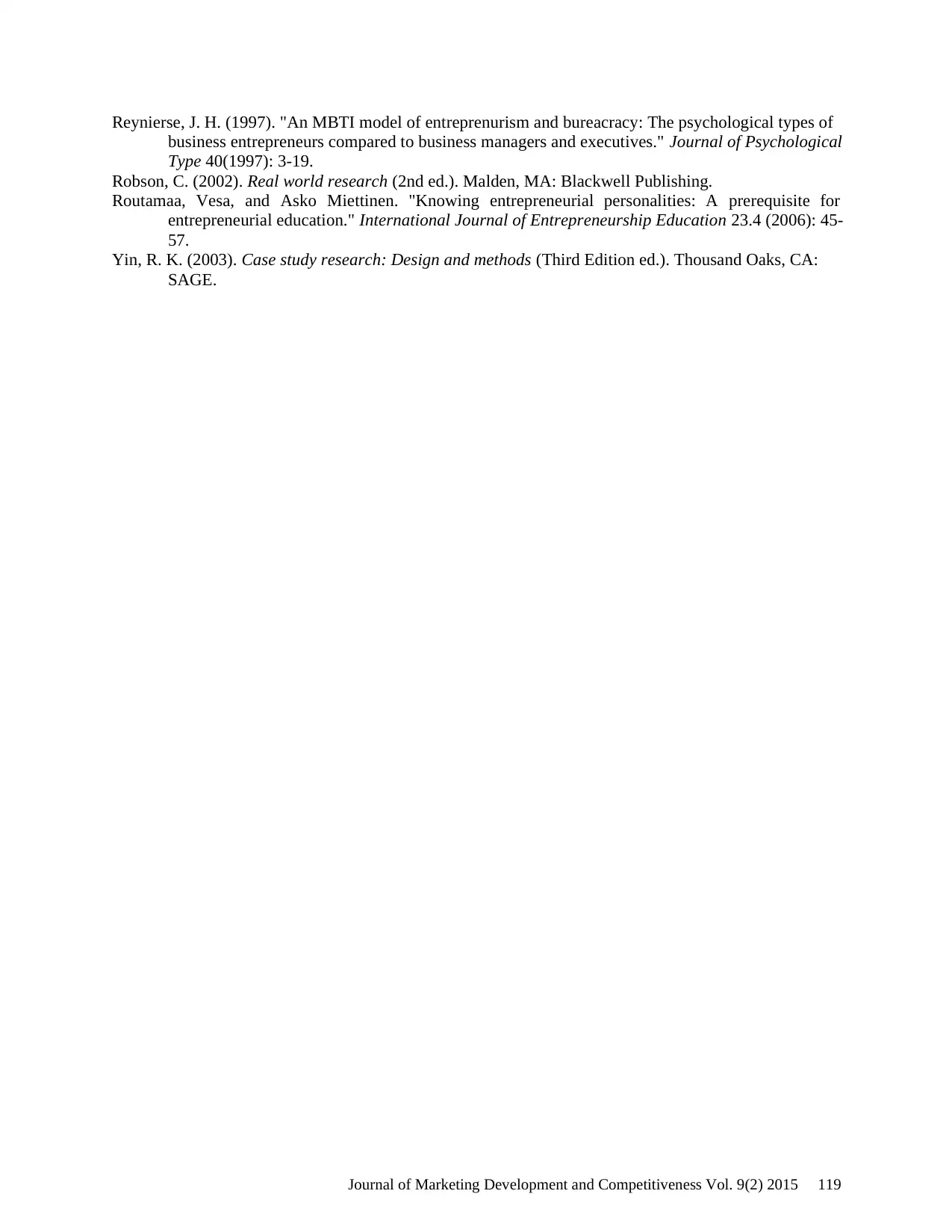
Reynierse, J. H. (1997). "An MBTI model of entreprenurism and bureacracy: The psychological types of
business entrepreneurs compared to business managers and executives." Journal of Psychological
Type 40(1997): 3-19.
Robson, C. (2002). Real world research (2nd ed.). Malden, MA: Blackwell Publishing.
Routamaa, Vesa, and Asko Miettinen. "Knowing entrepreneurial personalities: A prerequisite for
entrepreneurial education." International Journal of Entrepreneurship Education 23.4 (2006): 45-
57.
Yin, R. K. (2003). Case study research: Design and methods (Third Edition ed.). Thousand Oaks, CA:
SAGE.
Journal of Marketing Development and Competitiveness Vol. 9(2) 2015 119
business entrepreneurs compared to business managers and executives." Journal of Psychological
Type 40(1997): 3-19.
Robson, C. (2002). Real world research (2nd ed.). Malden, MA: Blackwell Publishing.
Routamaa, Vesa, and Asko Miettinen. "Knowing entrepreneurial personalities: A prerequisite for
entrepreneurial education." International Journal of Entrepreneurship Education 23.4 (2006): 45-
57.
Yin, R. K. (2003). Case study research: Design and methods (Third Edition ed.). Thousand Oaks, CA:
SAGE.
Journal of Marketing Development and Competitiveness Vol. 9(2) 2015 119

Reproduced with permission of the copyright owner. Further reproduction prohibited withou
permission.
permission.
1 out of 7
Related Documents
Your All-in-One AI-Powered Toolkit for Academic Success.
+13062052269
info@desklib.com
Available 24*7 on WhatsApp / Email
![[object Object]](/_next/static/media/star-bottom.7253800d.svg)
Unlock your academic potential
© 2024 | Zucol Services PVT LTD | All rights reserved.





